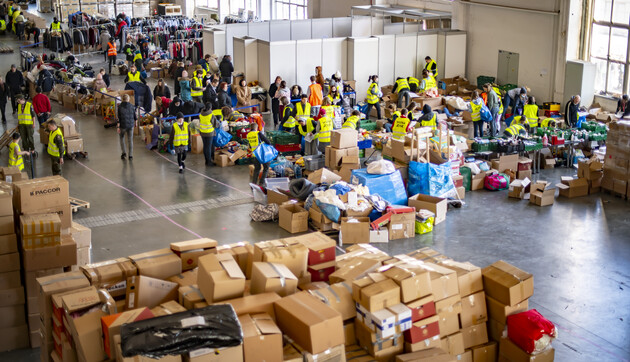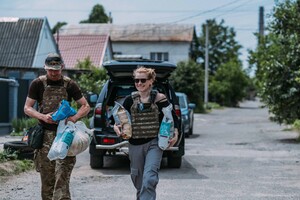What’s wrong with international humanitarian aid in Ukraine and the world and how to make it more systematic
Any war always (to one degree or another) leads to a humanitarian crisis or disaster. Especially if it is a long war. It is difficult to imagine Ukraine after 2014 without the humanitarian movement: thanks to this, we keep both the front and the rear.
It is already obvious that the need for humanitarian aid will not disappear even after our victory. But it is worth thinking about how to build this system in the most effective way – so as not to become addicted to constant humanitarian need, but to use this opportunity to build long-term solutions. And eventually become a strong state that does not need humanitarian support from the world (or needs it minimally).
This article is my personal observation as someone who has been working in development and humanitarian aid system for over 15 years.
After 2014, when Russia first encroached on our territorial integrity, international funds began to actively help Ukraine, and it was necessary to somehow coordinate it. For this, a system of humanitarian aid through cluster distribution was gradually launched.
What does it look like? All support from international funds is divided into 11 clusters: for instance, in education, access to water and hygiene, housing, protection, logistics, health, etc. Which cluster is relevant for a particular country depends on its problems and needs.
However, this system has several important drawbacks. Let’s first consider the objective ones:
- The number of crises and needs in the world is constantly increasing. According to studies carried out even before February 24, every 33rd person in the world was already in need of humanitarian assistance or protection at that time. That’s more than at any time since World War II. Almost 80 million people were then displaced because of conflict and violence.
- Often, the governments of the countries themselves are not ready for systemic solutions, political factors etc. sometimes prevent humanitarian aid from being provided.
- The humanitarian cluster system is a multi-level bureaucratic system. The lion’s share of the funds that are provided for aid settles in its governing bodies.
Now let’s talk about subjective ones.
In his piece What’s Wrong with Humanitarian Aid System, Mark Lowcock, Secretary-General for Humanitarian Affairs at the Center for Global Development, identifies the following shortcomings:
1) Agencies do not pay enough attention to the real needs of people in crisis. Despite all our good intentions, the humanitarian system is built in such a way that international organizations and donors give people what they think is best and what they can offer and pay little attention to the real needs of communities and families. And it should be the other way around. That is why volunteer initiatives that were easier to adapt to people’s needs worked so well in Ukraine in 2022.
I recall here the experience of 2014, when I worked in several international humanitarian organizations and participated in cluster meetings. The level of communication was very ineffective – so much so that some local organizations refused to participate in such meetings. For example, warm blankets, which were needed in winter, arrived only in June.
2) Humanitarian aid system can often breed consumerism and paternalism in those receiving aid when they are helped on an ongoing basis without being told that it will soon end, and they will have to survive on their own. According to the international standard, it is believed that after a country receives powerful humanitarian aid from various donors, a period of recovery should come. That is, the state must create jobs, retrain people who have moved, rebuild infrastructure, and later (or even simultaneously) move on to development projects.
If the chain does not work and the humanitarian aid system is delayed, it can create a whole set of complex problems. Thus, already since 2017, many Ukrainian volunteer organizations that worked on the dividing line of Donetsk and Luhansk regions noticed that some families who remained there began to abuse this situation. They used their residence on the demarcation line to constantly receive humanitarian and monetary aid. They continued to give birth to children, not caring about their well-being, abusing alcohol, and not giving their offsprings a chance for normal education, communication and development. And humanitarian organizations, in turn, continued to receive projects, salaries and demonstrated to donors that there are people in Ukraine who need help.
3) In many international humanitarian organizations, clear protocols for the provision of any aid are prescribed. For example, many international organizations that provide psychological support services very clearly regulate the categories, consultation time, number of possible services, etc. It is about quantity indicators that often dominate over quality.
Psychologists say that they have to stop providing psychological support to a person who has recently lost someone close to them, because only 30 minutes of consultation are allocated to her, and the rest of the time is not covered by funding. Or only one or two appointments are covered, and the person needs more to stabilize their condition. Specialists are frustrated by the project’s inability to meet people’s real needs.
These standards are written in such a way to mechanize certain processes, but from the point of view of common sense and empathy, this is a difficult challenge for Ukrainian specialists, especially when they work in their country and see these needs not in theory;
4) Local organizations are often perceived purely as executors of any project. Meanwhile, project ideas and indicators of their effectiveness, vision of changes through the project, etc. are made up by people who may never even have been to Ukraine. As a result, we have standard solutions that are unsustainable in Ukrainian realities. At the same time, Ukrainian organizations do not always feel in a position to influence this. Most projects are so bureaucratized that they leave very little room for maneuver.
What to do with it and how to build work more systematically
When meeting with international organizations, we often say: “We and our children are to live here, so we think ten years ahead.”
Working in the Ukrainian fund with psychological support programs, we focus on the one hand, on existing standards, and on the other hand, on real needs on the ground. For example, at the beginning of a full-scale war, when many people had to leave their homes, some solutions were needed. Now we are observing other challenges, in particular in the de-occupied territories and in the frontline areas.
In researching the question of how to build a more systematic humanitarian aid system, particularly in the psychological aid sector, we concluded that building communities and creating comprehensive solutions is very important. Not every child needs a psychologist, but certainly every child needs a supportive environment to cope with the experience of war. Similar conclusions are drawn by experts during the Save the Children Denmark world conference:
- Services provided in the community should be as inclusive and cross-sectoral as possible. For example, basic, educational, and psychological needs shall be covered together. When it comes to psychological support for children, it should be provided to the whole family, not just the child. If the organization works with psychological help, it must, together with the community and other organizations, take care of the availability of shelter, decent indoor conditions, etc.
- Programs must be deeply rooted in the community and reflect its context. Often, Ukrainian organizations receive from international organizations templates from the countries where they are used to working. However, most of these countries are neither European nor Christian. Accordingly, not all those practices can and should be applied here, because they frustrate the local population.
- Assistance should not only respond to problems, but also be preventive in order to timely identify and counteract neglect, violation of the rights of the child in the community and family. Accordingly, it should be more long-term and aimed at creating services at the community level, and not just one time.
- Organizations should involve teenagers, young people, and local activists in creating support programs so that they learn to formulate needs and be involved in community life and project formation. It is necessary to create opportunities for the community to self-heal through volunteering, joint events (in particular, creative ones), training, and in this way form the self-reliance of communities, and not just provide one-time services or help.
Read this article in russian and Ukrainian.
Please select it with the mouse and press Ctrl+Enter or Submit a bug














 Login with Google
Login with Google